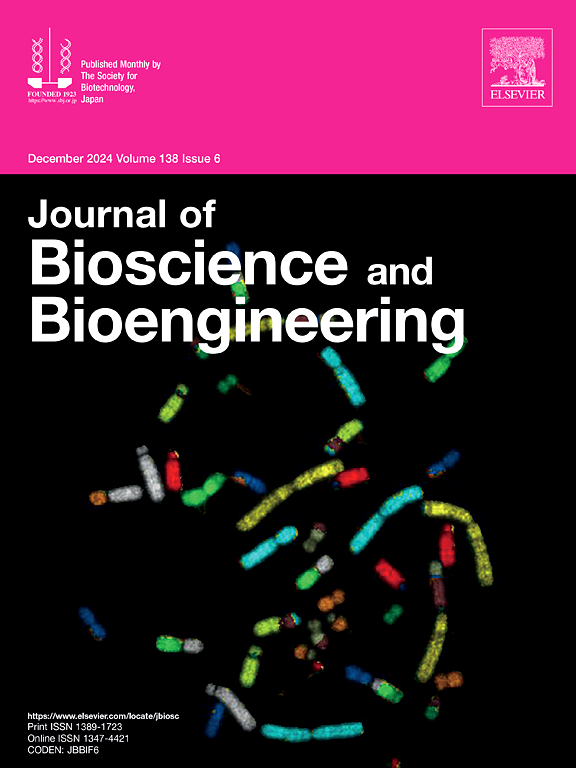Glycolytic inhibition by resveratrol facilitates chondrocyte survival under glucose-deprived conditions and improves the viability of 3D-cultured cartilage tissue
IF 2.9
4区 生物学
Q3 BIOTECHNOLOGY & APPLIED MICROBIOLOGY
引用次数: 0
Abstract
Decreased cell viability resulting from severe nutrient deprivation is a major obstacle in three-dimensional (3D) tissue construction. Therefore, technical improvements that prevent cell death in the core region of cell aggregates are desired for the development of large, thick tissues. We focused on the anti-glycolytic effects of resveratrol (RSV), a polyphenol known as a caloric restriction mimetic, and investigated its cytoprotective effects under glucose-deprived conditions in two-dimensional (2D) and 3D-cell culture systems using rat chondrocytes. In 2D culture, the low-glucose (LG, 0.5 mg/mL) condition caused time- and dose-dependent cell death in chondrocytes, whereas co-treatment with 50 μM RSV significantly restored cell viability under glucose deprivation. In RSV-treated cells, the expression levels of glycolytic genes (GLUT1, PKM, and LDHA) and glucose uptake were significantly downregulated, and phospho-AMPK levels were upregulated, indicating energy stress. RSV treatment restored the expression of extracellular matrix genes (COL1A1 and COL2A1), which were downregulated under the LG condition, and augmented the pro-chondrogenic effect of TGF-β1 and ascorbic acid. In a 3D-culture model, spheroids constructed with RSV-pretreated chondrocytes had a more viable core region than dimethyl-sulfoxide-treated control spheroids. TGF-β-induced cartilage maturation led these spheroids to develop larger and more viable tissues than control spheroids. These results suggested that glycolytic inhibition by RSV decreased chondrocyte glucose usage, thereby preventing cell death caused by glucose deprivation. Our findings provide useful information for improving cell viability under hyponutrition conditions and can be applied to 3D tissue construction.
白藜芦醇的糖酵解抑制促进了葡萄糖剥夺条件下软骨细胞的存活,提高了3d培养软骨组织的活力。
严重的营养剥夺导致的细胞活力下降是三维(3D)组织构建的主要障碍。因此,防止细胞聚集核心区域的细胞死亡的技术改进是大而厚的组织发育所需要的。我们专注于白藜芦醇(RSV)的抗糖酵解作用,白藜芦醇是一种多酚,被称为热量限制模拟物,并在使用大鼠软骨细胞的二维(2D)和三维细胞培养系统中研究了它在葡萄糖剥夺条件下的细胞保护作用。在2D培养中,低糖(LG, 0.5 mg/mL)条件导致软骨细胞的时间和剂量依赖性细胞死亡,而与50 μM RSV共处理可显著恢复葡萄糖剥夺下的细胞活力。在rsv处理的细胞中,糖酵解基因(GLUT1、PKM和LDHA)和葡萄糖摄取的表达水平显著下调,磷酸化ampk水平上调,表明能量应激。RSV处理恢复了LG条件下下调的细胞外基质基因COL1A1和COL2A1的表达,增强了TGF-β1和抗坏血酸的促软骨形成作用。在3d培养模型中,用rsv预处理的软骨细胞构建的球体比二甲亚砜处理的对照球体具有更有活力的核心区域。TGF-β诱导的软骨成熟导致这些球体比对照球体发育更大、更有活力的组织。这些结果表明RSV抑制糖酵解降低了软骨细胞葡萄糖的使用,从而防止了葡萄糖剥夺引起的细胞死亡。我们的发现为在低营养条件下提高细胞活力提供了有用的信息,并可应用于3D组织构建。
本文章由计算机程序翻译,如有差异,请以英文原文为准。
求助全文
约1分钟内获得全文
求助全文
来源期刊

Journal of bioscience and bioengineering
生物-生物工程与应用微生物
CiteScore
5.90
自引率
3.60%
发文量
144
审稿时长
51 days
期刊介绍:
The Journal of Bioscience and Bioengineering is a research journal publishing original full-length research papers, reviews, and Letters to the Editor. The Journal is devoted to the advancement and dissemination of knowledge concerning fermentation technology, biochemical engineering, food technology and microbiology.
 求助内容:
求助内容: 应助结果提醒方式:
应助结果提醒方式:


